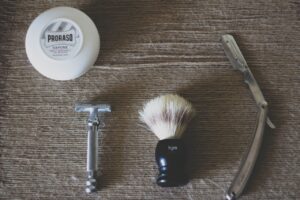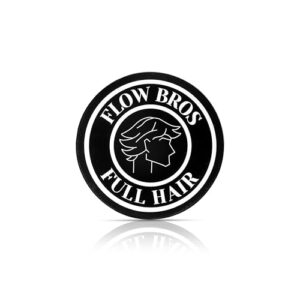Quick Start: Why a Clean Neckline Changes Everything
Start with clean, dry hair and a little confidence: shaping your beard and neckline is simple. This six-step guide gives clear, practical tools, measurements, and finishing tips so you achieve a sharp, professional look at home without costly barber visits.
Tools and Time You'll Need
Step 1: Clean and Dry — Start with a Blank Canvas
Why damp hair ruins your lines (and the one minute trick that fixes it)Begin by washing your face and beard with a gentle cleanser or beard shampoo. Pat everything thoroughly dry—damp hair lies flatter and gives misleading lengths.
Comb your beard downward and through to detangle. Trim stray long hairs with scissors so they don’t skew your measurements. Set a fixed length with a trimmer guard for uniformity.
Stand in front of a well-lit mirror and use a handheld mirror to check angles. Good lighting and dry hair make your measurements accurate, reduce mistakes, and speed up shaping.
Important checklist:
Take deep breaths to steady your hand.
Step 2: Determine Your Neckline — Find the Sweet Spot
Stop copying strangers — a simple angle rule makes it personalPlace two fingers horizontally above your Adam’s apple. Imagine a smooth, curved line running from just behind each ear down to that point. Keep the fingers as a consistent reference—this is often lower than people think.
Mark the curve with small dots using the trimmer tip or a washable marker. Make the dots close together so you can connect them easily. Avoid the rookie mistake of cutting too high; it visually hollows out the jaw.
Tilt your head slightly back for the first pass so the line falls naturally when you return upright. Step back and check symmetry from different angles with a handheld mirror.
Step 3: Map Your Cheek Lines — The Difference Is in the Angles
Want sharper cheekbones? A 45-degree rule cuts years off your faceMap a diagonal line from the bottom corner of your sideburn down toward the corner of your mouth—aim for roughly a 45° angle.
Use a precision trimmer or razor to create the line, but trim slowly and step back often to check balance. Trim a little at a time; an overly sharp move is hard to undo.
For fuller beards, soften the line into a gentle curve; for minimalist styles, sharpen the diagonal for more definition. Example: a rounded face looks longer with a soft curve; a square jaw pops with a crisp angle.
Remove stray hairs above the line with short, deliberate strokes. If your cheeks are patchy, raise the cheek line slightly and blend the transition with a short guard.
Step 4: Trim the Bulk — Blend Lengths Like a Pro
Lose the lumberjack look—here's how to soften the transition without losing styleStart with a longer guard than your target length. If you want a 4 mm finish, begin with 6 mm, then move to 5 mm—work down one guard at a time to avoid surprises.
Use a comb to lift hair and trim against the grain for an even cut; hold the comb at 90° to the face so blades catch all hairs. Example: comb from cheek to chin and sweep the clipper upward in controlled passes.
Switch to a shorter guard near the neckline and jawline so the beard naturally tapers toward skin.
Snip stray long hairs and tidy the mustache with scissors.
Step back, run your fingers through the beard to find uneven patches, and make small corrective passes.
Finish with a precision trimmer on edges, apply light beard oil to condition, and use balm for shape; check proportions from all angles regularly.
Step 5: Define the Mustache and Lip Line — Don’t Ignore the Centerpiece
A neat mustache makes the whole beard look intentional — here's the micro-sculpting trickTreat the mustache as the focal point: trim the bulk so it doesn’t cover the upper lip, but avoid creating an overly thin strip.
Comb the hairs downward. Trim vertically with small snips or use a trimmer with a guard for even length. If hairs touch your lip when you sip coffee, shorten them a touch.
Point-trim around the philtrum to create a clean edge. Remove stray hairs that bridge the mustache and nose.
Slightly taper the mustache toward the corners of the mouth and check that the lip line mirrors the beard’s symmetry and doesn’t tilt.
Finish by moisturizing the skin and, if you use product, apply a pea-sized amount of wax or balm to shape without stiffness. Trim tiny amounts every few days to keep the shape crisp.
Step 6: Final Touches — Razor Lines, Care, and Maintenance
Shave smarter: the aftercare routine that keeps your lines fresh for weeksUse a clean razor or precision trimmer to sharpen cheek lines, neckline, and mustache borders. Shave slowly with short strokes and keep skin taut to avoid nicks — for example, pull the jawline skin slightly upward when outlining the neck.
Rinse and pat dry. Apply an alcohol-free aftershave or soothing balm to calm irritation. Massage a few drops of beard oil through the hair to condition and add subtle shine; comb through to distribute evenly.
Establish a maintenance schedule:
Carry a travel trimmer for emergency tidy-ups between touch-ups.
Finish: Confidence in Six Steps
Follow these six steps weekly or as needed to maintain a clean, tailored beard and neckline; small, consistent trims and proper aftercare keep you sharp. Practice builds skill—try it, share your results, and show the world your confidence right now.












Love the tone of this guide — not preachy, just step-by-step. A couple of notes from my experience:
– If you have a patchy beard, don’t overdefine cheek lines — softer curves look more natural.
– For neckline, tilt your head back slightly and find the point where the neck meets the underside of the jaw.
Also, would love a short video for Step 4. Blending lengths is one thing I still watch others do before trying myself.
+1 for the video. Even a 30-second clip showing guard sizes and motion would be super helpful.
Noted. We’ll prioritize a blend demo in the next update — covering guard choices and clipper angles.
Great point about patchy beards, Aisha — softer cheek lines can mask uneven growth. We’ll consider adding a short demo vid for blending.
Thanks Jordan — exactly. Even just showing one side being trimmed helps you mirror it on the other side.
I loved reading this step-by-step. A few personal notes:
– I have sensitive skin, so after Step 6 I always apply an alcohol-free aftershave balm. Avoids razor burn.
– For mustache definition, I trim vertically first, then horizontally — clearer results.
– If you’re unsure about neckline placement, use your finger to trace the jaw, then shave just above that line.
No replies needed, just wanted to share — hope it helps someone!
Guide was ok. I followed steps and still looked like a hedgehog for a week. Maybe I’m cursed. 🤷♂️
Haha — beard growing is an unpredictable journey. Did you try trimming the bulk first and defining after a day or two of growth? That often helps make the lines cleaner.
Great quick start — I never realized the neckline could change the whole look. Kept it simple and the ‘find the sweet spot’ tip actually saved me from a weird double-chin line. Short and useful, thanks!
Agreed — I used a #3 guard to trim the bulk first, then a straight razor for the final line. Made a huge difference.
Glad it helped, Mark! If you want, mention what tools you used (clipper length or razor) and I can suggest a follow-up for blending.
Nice technique, Sophie. Using a guard to remove the bulk before defining is exactly Step 4 + Step 6 in action.
Question: when trimming the bulk (Step 4), do you recommend going against the grain or with it? I usually go against the grain and it feels like I’m taking too much off sometimes.
Thanks — I’ll try that next time instead of the aggressive against-the-grain approach.
With the grain first, always. Saves you from over-trimming.
Trim with the grain for initial passes to remove bulk and avoid cutting too close. Go against the grain for a final, even trim if you want a closer cut — but do that cautiously.
I tried mapping my cheek lines and ended up with one higher than the other. Any quick fixes without shaving it all off?
If one line is higher, try subtly softening the sharper side: trim a tiny bit lower on the higher side to create symmetry. Use a comb to compare both sides before committing.
If it’s small, a beard filler (tinted pencil) can visually even it out till it grows out. Otherwise, trim the lower side up a hair or soften the higher side into a curve.
Long post incoming — sorry not sorry. I’ve been growing and shaping beards for 10 years (off and on) and here’s what I tell clients:
– Neckline: imagine a curved line from just behind your Adam’s apple to under the ear. Too high and you lose density; too low and you get the ‘neckbeard’ effect.
– Cheek lines: follow natural hair growth, but don’t be scared to sculpt if you want a cleaner look.
– Trimming bulk: work in layers. Start with longer guards and reduce length gradually.
– Mustache: comb, trim the middle with scissors, then tidy edges with a trimmer.
– Maintenance: once a week touch-up for most guys, more often if you have fast growth.
Also: if you use products, a lightweight beard oil helps the hair sit where you want it. No heavy wax unless you’re styling something bizarre 😅
Thanks! And yes, weekly touch-ups are the sweet spot for most people.
Fantastic, Olivia — practical client advice. The ‘curved line’ mental image for the neckline is one of the clearest descriptions I’ve seen.
Agree on the layered trimming. I used to go straight to a short guard and regretted it every time.
I appreciate the straightforward language. A small suggestion: add recommended guard numbers for different beard lengths in Step 4. Would have saved me a few experiments. Otherwise, great breakdown.
Glad others want it too — saves time and product money 😂
Noted — we’ll include guard recommendations and common mistakes to avoid.
Good suggestion, Sophia. We’ll add a quick guard-number table (e.g., #4 for stubble, #2–3 for short full beard, etc.). Thanks!
+1. I wasn’t sure whether to use a #3 or #4 and kept switching. A baseline would be super helpful.
This guide gave me the courage to try shaping my partner’s beard for the first time. Turned out better than expected. He now insists I be the official barber 😂
Nice! Happy it worked out. Tell him to bring snacks for his new barber 😉
Simple and concise. My only gripe: the photos could show more close-ups of cheek-line angles. Otherwise, very usable guide.
Agreed — close-ups helped me once I saw someone angle the clipper differently.
Thanks, James. We’re planning to add close-up photos for each step in the next edit.
Step 6: final touches = instant confidence. Wife approved so mission accomplished 😂✂️
This guide is solid, but here’s a small checklist I use at the sink — thought it might help others:
– Wash & dry (Step 1)
– Comb beard downward
– Trim bulk with longer guard (Step 4)
– Shorten on jawline & under chin (Step 2/4)
– Define mustache with scissors, use a lip guard (Step 5)
– Finish with a cold splash and a tiny dab of balm (Step 6)
If you’re new: go slow. Trimming is reversible; razoring isn’t. Took me a while to learn that the hard way. 😉
Excellent checklist, Grace — that ‘trimming reversible’ reminder is so important. People rush to the razor too soon.
Good tip about the lip guard! I always end up trimming too much off the center when I go quick.
Agree on the scissors — they give precision the clippers can’t. We’ll add a recommended tools mini-list in the finish section.
Cold splash + balm is underrated. Makes my neckline look crisp and skin not like dried leather.
Thanks! Also, invest in a decent pair of barber scissors — they make mustache work so much easier.
Okay real talk — Step 3 (cheek lines) is where I always mess up. Here’s what worked for me:
1) Stand in natural light
2) Look straight into a mirror
3) Use your jawbone as the guide and don’t try to make it perfectly symmetrical in one go
Also, I messed up my left side twice before getting it right, so don’t beat yourself up. Typos incoming: I wrote “cheeklines” as one word for a week 😅
Haha I can relate. I usually draw a faint guideline with a washable eyebrow pencil before going in with the trimmer. Saves me from those ‘oops’ moments.
Thanks for sharing your step-by-step, Emily — that jawbone tip is gold. Symmetry takes practice; trimming a little at a time prevents overcorrection.